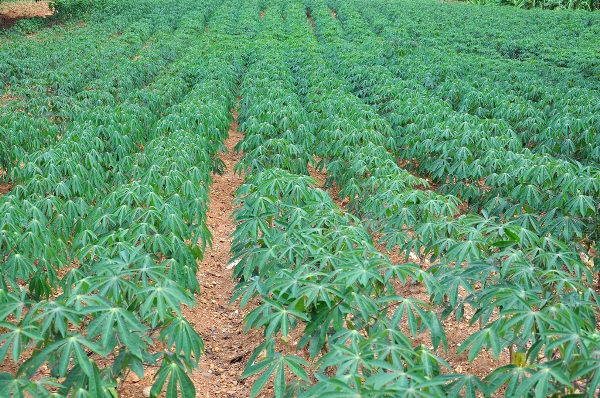Tapioca Cultivation in India: Here’s Everything You Need to Know

Tapioca, or cassava, is a tropical plant cultivated for its starchy roots. It is widely grown in southern India, particularly in Kerala, Tamil Nadu, Karnataka, and Andhra Pradesh. With wide food and industrial uses, tapioca offers profitable returns to farmers due to high demand for starch, sago, and sabudana. As a result, tapioca farming has been increasing in recent years.
This guide covers soil, climate, and other essentials to help you start tapioca farming in India. The guide also highlights popular tractors with their costs, including the John Deere tractor price and the Swaraj tractor price, to help you choose the best fit for your farm.
Growing Requirements for High-Yield Tapioca Farming in India
Here, we discuss the soil, climate, and other essentials needed for profitable tapioca production:
Soil
Tapioca grows best in well-drained, sandy loam or red lateritic soils that are loose enough for the tuberous roots to expand. However, a hardpan layer below the surface layer is recommended to prevent roots from growing too deep.
- Soil texture: Sandy loam, loamy soils, and light clay. Avoid heavy clay that hinders root bulking.
- Soil depth: At least 30–45 cm deep for proper root penetration.
- pH range: Slightly acidic to neutral (5.5 to 7.0).
- Drainage: Good drainage is crucial, as waterlogging can damage roots.
Climate
Cassava (tapioca) thrives in India under warm, humid tropical conditions with moderate rainfall. The ideal climate requirements are:
- Temperature: Best growth at 25–29°C; tolerates 20–35°C. Prolonged temperatures below 15°C slow growth, while >38°C with drought stress reduces yields.
- Rainfall: Tapioca is a drought-tolerant crop, but a well-distributed rainfall supports good growth.
- Sunlight: 6-8 hours daily
- Season: Planted at the beginning of the rains (June–July in rainfed areas, October–November with irrigation) for best establishment.
Seed Varieties
Sree Kaveri, Sree Harsha, Sree Apoorva, Sree Visakham, Sree Padmanabha, Co 2, Co 3, CO (TP) 4, MVD 1, H 165, and H 226 are popular tapioca varieties in India. These varieties have different characteristics, such as high yields, early maturity of 7 to 8 months, and high starch content.
In addition, farmers also choose varieties that are pest and disease-resistant to reduce their chemical use. Sree Vijaya and Sree Rekha, for instance, are tolerant to mosaic disease, helping farmers lower costs.
Irrigation
Tapioca is both a rainfed and irrigated crop, depending on the rainfall availability of the region. In Kerala and parts of Tamil Nadu, tapioca is often grown rainfed using monsoon rains. In irrigated belts, including Tamil Nadu, Andhra Pradesh, and Karnataka, regular irrigation is adopted for higher yields.
The first irrigation is provided at the time of planting. The first life irrigation is given on the third day, with additional watering occurring once every 7 – 10 days until the third month and once every 20 – 30 days until the eighth month following planting.
Additionally, drip irrigation is recommended to ensure uniform moisture and increase yield and starch content.
Pest and Disease Management
Tapioca is susceptible to bacterial blight and cassava mosaic virus disease, such as Tottikappa and Kalikalan. Furthermore, the crop is also attacked by pests, such as mites, whitefly, and spiralling whitefly.
As a result, farmers grow resistant varieties and follow sustainable management practices for pests and diseases, including disease-free cuttings, crop rotation, and neem oil or bio-controls to obtain healthy crop harvesting.
Harvesting
All varieties of tapioca are harvested after 8-10 months of planting, as factories only accept tubers harvested before March. Harvest when leaves turn yellow and tubers are fully developed.
Manual harvesting is common in small farms, but it is extremely labour-intensive. Therefore, large farms rely on bullock-drawn or tractor-mounted root diggers for faster and easier harvesting.
What is the Right Tractor for Your Tapioca Farm?
Tapioca farming demands the right tractor specifications to manage deep tillage, ridging, inter-row cultivation, spraying, and heavy haulage at harvest.
Tractor HP
Tapioca is cultivated on well-drained, sandy and loamy soils, for which tractor models with 35-55 HP are the most suitable. Sandy and loamy soil are light and easy to plough. Tractors in the 35-55 HP range can efficiently perform light tillage, rotavation, interculture, and work well with small implements.
For larger areas, 50–55 HP tractors provide more torque, enabling faster coverage with bigger implements and improving overall productivity.
Lifting Capacity
Tapioca farming requires a strong lifting capacity to operate soil-working tools and ridge makers. A minimum of 1,500–2,000 kg ensures smooth handling of heavy implements like disc ploughs, cultivators, and ridgers. A higher lifting capacity also adds flexibility for commercial farmers using modern or multi-row equipment.
Price Range
For tapioca farmers in India, Swaraj Tractors can be a good choice because of their competitive prices. The Swaraj 744 FE price ranges from Rs 7.31 to Rs 7.84 lakh in the 45 HP category, making it a popular choice among small and medium farmers.
John Deere tractor models, such as 5050 D (50 HP) or 5310 with 55 HP, are well-suited for commercial tapioca growers needing higher capacity. The price of these models is between Rs 8.46 lakh and Rs 12.84 lakh.
Conclusion
Tapioca farming in India is expanding with the rising market demand and high profitability. Choosing the right soil, climate, variety, and irrigation is important to ensure high yields. In addition, proper pest control and timely harvesting are also crucial to protect quality. Moreover, the right tractor with balanced HP, lifting capacity, and price will help you achieve efficiency and sustainable returns.



